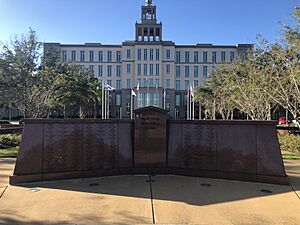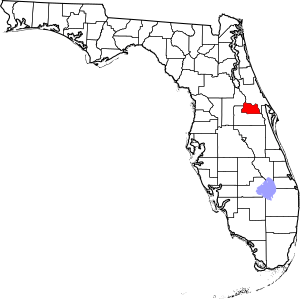Seminole County, Florida facts for kids
Quick facts for kids
Seminole County
|
|||
|---|---|---|---|
|
County
|
|||

Fallen Heroes Memorial at the Seminole County Criminal Justice Center
|
|||
|
|||

Location within the U.S. state of Florida
|
|||
 Florida's location within the U.S. |
|||
| Country | |||
| State | |||
| Founded | April 25, 1913 | ||
| Named for | Seminole people | ||
| Seat | Sanford | ||
| Largest city | Sanford | ||
| Area | |||
| • Total | 345 sq mi (890 km2) | ||
| • Land | 309 sq mi (800 km2) | ||
| • Water | 36 sq mi (90 km2) 10.4%% | ||
| Population
(2020)
|
|||
| • Total | 470,856 |
||
| • Density | 1,524/sq mi (588.6/km2) | ||
| Time zone | UTC−5 (Eastern) | ||
| • Summer (DST) | UTC−4 (EDT) | ||
| Congressional district | 7th | ||
Seminole County is a county located in the central part of Florida, a state in the United States. As of the 2020 census, about 470,856 people lived here. This makes it the 13th most populated county in Florida.
The main city and county seat is Sanford. Seminole County is also part of the larger Orlando-Kissimmee-Sanford area, which is a big group of cities and towns connected together.
Contents
History of Seminole County
Florida was first divided into two large counties in 1821: Escambia in the west and St. Johns in the east. Later, in 1824, the area south of St. Johns County became Mosquito County. Its main town was Enterprise.
How Seminole County Got Its Name
In 1845, when Florida became a state, Mosquito County changed its name to Orange County. Over the next 70 years, many new counties were created from these larger areas. Seminole County was one of the last to be formed.
Seminole County was officially created on April 25, 1913. It was formed from the northern part of Orange County by the Florida Legislature. The county was named after the Seminole people. These Native American people historically lived throughout this region. The name "Seminole" likely comes from the Spanish word cimarron, which means "wild" or "runaway."
Geography and Location
Seminole County covers about 345 square miles. Most of this area, about 309 square miles, is land. The remaining 36 square miles, or about 10.4%, is water. This makes it one of Florida's smaller counties in terms of land and total area.
Why Seminole County is Growing Fast
Seminole County is located between Volusia County and Orange County. This central location has helped it become one of Florida's fastest-growing counties.
The larger Orlando Metropolitan District includes Seminole, Osceola, and Orange counties. Nearby counties like Lake, Volusia, and Brevard also contribute to the area's growth. This region is a good place for new businesses and homes.
Neighboring Counties
Seminole County shares borders with several other counties:
- Brevard County, Florida - to the east
- Volusia County, Florida - to the north and east
- Orange County, Florida - to the south and west
- Lake County, Florida - to the west
People and Population
The population of Seminole County has grown a lot over the years. In 1920, there were about 10,986 people. By 2020, the population had reached 470,856.
Who Lives in Seminole County?
According to the 2020 census, there were 470,856 people living in the county. These people lived in about 178,094 households, with 120,049 of those being families.
In 2020, the population included:
- White (not Hispanic): 56.08%
- Black or African American (not Hispanic): 10.68%
- Asian (not Hispanic): 5.34%
- Mixed/Multi-Racial (not Hispanic): 4.42%
- Hispanic or Latino (of any race): 22.63%
- Other groups make up smaller percentages.
Households and Families
In 2000, about 33.9% of households had children under 18 living with them. About 54.3% were married couples. Around 11.5% were female householders without a husband present.
The average household had 2.59 people, and the average family had 3.07 people. In 2003, about 72,630 students were enrolled in schools. By 2020, the Seminole County School District was the 12th largest in Florida. It served over 67,000 students and employed 10,000 people.
Age and Income
In terms of age, about 25.4% of the population was under 18. About 10.6% were 65 years or older. The average age in the county was 36 years old.
In 2000, the average income for a household was $49,326. For a family, it was $56,895. The average income per person in the county was $24,591.
Libraries
The Seminole County Public Library System started in 1978. It has about 500,000 books and other materials. Each year, about 2.5 million books are borrowed.
There are five library branches in Seminole County. You can find them in Casselberry, Sanford, Lake Mary, Oviedo, and Longwood. The library offers an online catalog where you can find e-books and audiobooks. To get a library card, you usually need to live in the county, own property there, be a student in a county public school, or work for the county government.
Education
Seminole County Public Schools is in charge of all the public schools in the county.
Transportation
Getting around Seminole County is easy with several major roads and public transport options.
Major Roads and Expressways
 Interstate 4: A major highway connecting different parts of Florida.
Interstate 4: A major highway connecting different parts of Florida. Seminole Expressway (SR 417): A toll road that helps people travel quickly.
Seminole Expressway (SR 417): A toll road that helps people travel quickly. Wekiva Parkway (SR 429): Another important toll road.
Wekiva Parkway (SR 429): Another important toll road.
Local Roads
Airports
- Orlando Sanford International Airport: This airport serves the area for air travel.
Public Transportation
- Lynx: Provides bus services for public transport.
- SunRail: A commuter rail system that connects Seminole County with other parts of the Orlando area.
Communities in Seminole County
Seminole County has several cities and other communities where people live.
Cities
Census-Designated Places (CDPs)
CDPs are areas that are like towns but are not officially incorporated as cities.
- Black Hammock
- Chuluota
- Fern Park
- Forest City
- Geneva
- Goldenrod (partly in Orange County)
- Heathrow
- Midway
- Wekiwa Springs
Unincorporated Communities
These are smaller communities that are not part of any city or CDP.
- Bertha
- Indian Mound Village
- Lake Monroe
- Slavia
- Sanlando Springs
- Taintsville
- Tuskawilla
Images for kids
See also
 In Spanish: Condado de Seminole (Florida) para niños
In Spanish: Condado de Seminole (Florida) para niños





